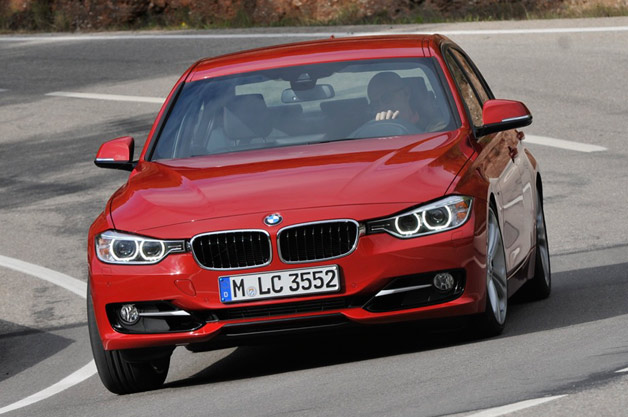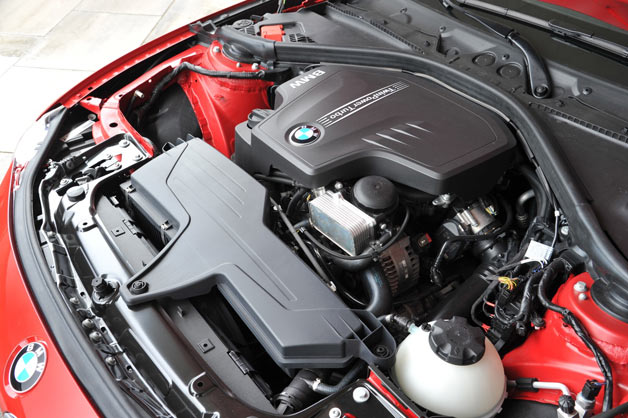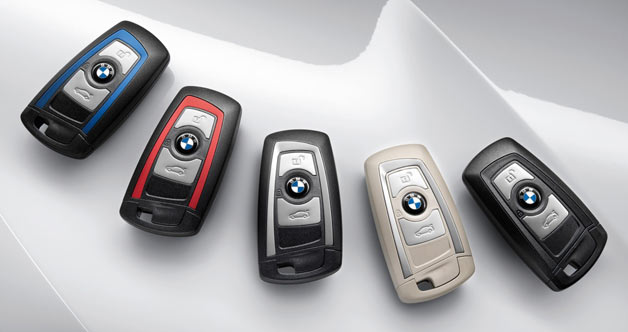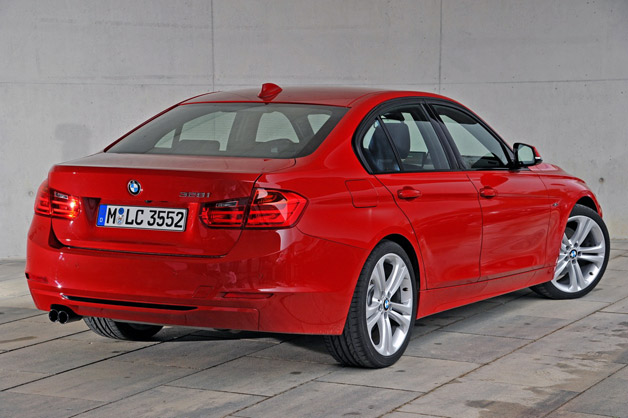-
EngineTurbo 2.0L I4
-
Power240 HP / 260 LB-FT
-
Transmission8-Speed Auto
-
0-60 Time5.7 Seconds
-
DrivetrainRear-Wheel Drive
-
Curb Weight3,320 LBS
-
Seating2+3
-
Cargo17.0 CU-FT
-
MPG23 City / 32 HWY
You have to know you're a bit of an icon when your reputation and sales dominance are essentially intact after six generations. We can debate that statement from all sorts of angles in regards to the BMW 3 Series, but the bottom line is that this sedan is still the one to beat. So, after our long-awaited first drive in BMW's new F30, we ask: Does it still deliver the winning recipe for the entry-level luxury buyer?
The Audi A4, Mercedes-Benz C-Class, Lexus IS, Infiniti G, Acura TL and upcoming Cadillac ATS will not be denied, and the 3 Series doesn't enjoy quite the commanding lead it once did. On the other hand, over 12.5 million total sales for The Almighty Three since 1975 is nothing to be sniffed at.
When talking about the sort of high performance testing that we crave, initial drives like this can only go so far in satisfying. That's because we had the chance to drive two meat-of-the-sales-figures trims at this Barcelona, Spain launch: the new 320d Efficient Dynamics turbo diesel and the 328i with new TwinPower Turbo in-line four-cylinder.
We chose to focus hard on the 328i since it's confirmed that we'll get this 241-horsepower model along with the 302-hp 335i this February. The only other model slated for the U.S. is the 335-hp ActiveHybrid 3, arriving sometime during summer 2012. As to the future of turbo diesel power in the States, BMW North America has said it is quite keen to bring over either or both the 320d and a future 330/335d, though no firm decisions have been made.



Our 328i tester, painted a very E90 M3-like Melbourne Red, was chock full of option list darlings, many of which constitute new additions for the 3 Series, and a couple of them are even first in the segment. The biggest news is the eight-speed automatic that replaces the six-speed unit. Sixth gear is set at a 1:1 ratio, while seventh and eighth are fuel-saving highway cruising overdrive gears. Despite the greater ratio spread, this new unit weighs the same as the outgoing six-speed 'box.
BMW will continue to fit a six-speed manual as standard equipment, but there were no 328i units available at the launch thus equipped. That bummed us out a bit, as this 7,200-rpm four-cylinder figures to be an ecstatic thing with a self-shifter. We suspect that it will be pretty hard to find many manual-equipped 328i or 335i models on U.S. dealer lots, but there's always the order sheet. Yes, we know the eight-speed auto is great and the shifts are safely right at our fingers. And yes, the automatic in Sport+ mode can accelerate more quickly than the manual while also mustering slightly better fuel mileage. All of this is true, but we still crave our third pedal.Yes, the automatic in Sport+ mode can accelerate more quickly than the manual, but we still crave our third pedal.
So, making the best of it, our tester did its damnedest to impress us with the Sport Line's sport automatic software and options including multi-mode Driving Dynamic Control, sport steering and M Sport three-spoke wheel with shift paddles. Helping the car's dynamics were the optional adaptive M Sport suspension and the cost-option 19-inch M Sport wheels available only on Sport Line and M Sport Package cars. The 19-inch Bridgestone Potenzas on our car (225/40 front, 255/35 rear) proved to be a great way to communicate with the Spanish asphalt all day, be it damp or dry.
Take one look at all the two-lane provincial highways leading inland from the Spanish waterfront and you'll want a car like the new 3 Series to wend your way over them. The driving here is simply incredible and can last for days without end. There's no better way or place to test the worthiness of the 2.0-liter N20 with the eight-speed automatic. Was this combination capable of putting smiles on our faces?
One key to determining where this car fits on our love scale of one to ten is how it enters and exits these Catalan curves at speed. A base model 328i with no optional dynamic or drive-safety tech, the Clutch Pedal Package (yes, that's a joke) and standard 17-inch wheels would certainly have had us in a different groove storming over the mountains and valleys. With the load of helpers we had aboard, however, the 328i did everything we asked of it, exceeding its job description and doing it noticeably better than an E90 could.

All options set aside, there are some important numbers to crunch here, and they go some way toward explaining the improvement. This F30 sedan is 3.7 inches longer bumper-to-bumper, with a wheelbase that gains two inches. Height gain at the roof's peak is hardly worth measuring. While the loss in exterior width is miniscule, the front track is 1.5 inches wider and the rear track is up by 1.9 inches. From this more planted stance, BMW engineers subtracted about 90 pounds versus an equivalent E90 – particularly impressive considering these new dimensions. Meanwhile, both bending and twisting rigidity have been improved by roughly ten percent versus its predecessor. Appropriately, it was possible to feel these improvements gel through our hands, body and inner ear when hammering along.
When the road cleared and gave us an opportunity to let this duded-up 328i Sport Line strut its stuff, we poked off the stability controls by leaving the Driving Dynamic Control selector in Sport+, switched off the traction control and went for it. Understeer has been diminished, though on a 328i (versus, say, a 335i or M3) there is still some there as a reminder to heated drivers to cool their heels. Through the curves, with all traction and stability tech shuttered, the 328i activates its electronic limited-slip function to assist the rear differential. The result? Better handling than we expected for a model in the middle of the 3 Series range. When the tail goes a bit wide on exits, it is distinctly more satisfying and sporting than the heavier E90 328i.The 328i Sport Line is easily one of the best non-M/AMG/RS etc. drives – if not the best – that we've ever had in this class.
In our case, the combination of an M Sport adaptive suspension that snugs the chassis four-tenths of an inch closer to the road plus the improved sport steering assured that this is the finest 328i we've ever driven. We didn't have all its competitors handy for a comparison, but this 328i Sport Line is easily one of the best non-M/AMG/RS etc. drives – if not the best – that we've ever had in this class. As a representative of the new 3 Series, this bodes well for the entire range.

Thanks to the single twin-scroll turbocharger, any sense of old-school turbo lag and surge is effectively gone from the 2.0-liter four-cylinder. Throttle response is creamy good with the DDC in Eco Pro or Comfort mode, and still smooth but authoritative in either Sport or Sport+. So, yes, when you require the eight-speed automatic with or without the sport steering wheel and paddles, you really ought to get the DDC as well. Acceleration to 60 mph is quoted at 5.7 seconds, though we suspect quicker times will be easy to come by.
The engine's 260 pound-feet of torque is the biggest helper in urging this 3,320-pounder forward, and the full measure of twist is available from just 1,250 rpm all the way through 4,800 rpm. The compound aluminum-lead vented brake discs with single-piston floating calipers all around were utterly new on our tester, but they didn't seem to lag in their stopping abilities during our spirited break-in drive. In typical BMW fashion, though, the wheels required a lot of cleaning when it came time for photos... there was plenty of brake dust. Four-piston fixed M Sport brake calipers are available as an option.Through it all, our only real criticism with the four-cylinder N20 is its sound, whether at idle or under throttle.
Through it all, our only real criticism with the four-cylinder N20 is its sound, whether at idle or under throttle. At idle, the high-precision direct injectors give the motor and exhaust a voice that's too tinny, a tick-ting-tick-ting sound that is readily heard (watch the Short Cut above to hear it for yourself). Under power, the sound at our feet and under the hood is definitely that of a capable four-cylinder. Gone is the smoother, lower-register sound of the naturally aspirated 3.0-liter six. Some drivers may not notice all this, and it is perhaps a small price to pay for greater efficiency and driving pleasure with greater power and torque. Or one might simply opt for the superior sounds of the 335i. Either way, you'll get standard regenerative braking and start/stop to maximize economy. There are no EPA numbers just yet, but for the 328i sedan, BMW is estimating 23 mpg in the city and 32 mpg highway per U.S. gallon – a sizable improvement if accurate.

Because the not-yet-seen next generation 3 Series coupe and convertible will be distinctly separate from the 3 Series – and henceforth be named 4 Series – BMW wants to really pump up the amount of personalization possible with the sedan so it can stand essentially alone. BMW has yet to officially confirm or deny that the U.S. will get a new 3 Series Touring, so it makes sense that it's bringing over almost everything it has in its product planning arsenal for the F30 sedan. As trims go, there will be the Plain Jane base car, this Sport Line (think: red accents and black lacquer details), the Luxury Line (high gloss chrome), the Modern Line (satin-finish aluminum), as well as the M Sport Package. Each trim also gets its own color-coded key fob (above). It's like Audi's S Line trimmings gone berserk. Naturally, we expect both Audi and Mercedes-Benz to soon follow suit in exploding their options lists in pursuit of entry-level luxury buyers.
For visual impact, the most interesting trims are clearly the Sport Line and M Sport Package. As on our 328i Sport tester, there is the adaptive M Sport suspension, sport automatic eight-speed, a larger wheel option and more direct calibration of the steering, throttle and automatic transmission in the DDC's Sport+ mode. Plus, there are higher thresholds for the stability and traction control suites. Buyers of these two top trims will also be able to opt for the Driver's Package, which relaxes the top speed out to 155 mph. Standard cars will make do with a 130 mph top end.



Predictably, there's a sheaf of new 5-6-7 Series style safety options, and BMW ConnectedDrive is now available, too. Besides the eight-speed automatic, there is Surround View with side and top view, Parking Assistant, Active Blind Spot Detection System, Lane Departure Warning with camera-based Collision Warning system, and real-time traffic via the iDrive's navigation system. We were eager to try out the new hands-free trunk opener, but we waved and waved each leg near the bumper and nothing happened. As it turns out, none of the testers were equipped with this hokey-pokey feature. Oops.
At one point, someone came up to us and acted like they were blowing up the new 3 Series sedan with air to emphasize that all it takes to get a 7 Series is to fill the 3 Series with air. Yuck-yuck-yuck, but we have to admit they had a point. In fact, the most enjoyable way to drive our feature-stuffed 328i was to switch off all of the safety do-dads because everything kept beeping and the steering wheel never stopped vibrating to remind us of the thousands of ways it was looking out for us. We would never overload our own 3 Series with all of these bells and whistles, but BMW marketeers have made them all available in this segment for the first time. Choose wisely.




Similarly, inside this F30 sedan, we now see a fair approximation of a shrunken 5 Series. Very BMW all around, with few surprises. The Germans have personalized the interior stitching and detailing to go with whatever trim detailing you choose, for one thing. On the road, the cabin is right at home, sturdy and comfortable enough in equal measure. All controls are intuitively driver-oriented, the center dash angled seven degrees toward the pilot, as on the new 5 Series. The rear passenger area, meanwhile, is finally a place you won't mind putting your coworkers on the way to lunch, with roughly an inch more room for the knees and corresponding added space for the feet. Luggage space has swollen to 17.0 cubic feet, but if you release the 60/40 rear seatbacks, they'll fall down flat to easily double the usable carrying space.
The F30's drag coefficient has been honed down to just 0.26, which is class-leading stuff. Much of this is attributable to BMW's painstaking treatment of the underbelly of the car – there's not just a flat panel covering much of the tender bits, engineers have gone to the trouble of creating a strategically formed panel to reduce rear axle drag. Having said all that, we nonetheless noticed a rather good amount of wind noise coming over the front fenders and past the A-pillars and mirrors while at 80-mph Spanish highway cruising speeds. All is well with the chemistry of the car's various parts, but this wind noise did surprise us.



Looking at the profile, BMW is definitely going for a sportier standard issue car for the F30 3 Series, since the E90 has been criticized as a bit bland. The shape is clearly a wedge and the most striking bit is the front section that dips right down over the broader headlights. This, in turn, gives the hood a more athletic bent as it reaches up toward the base of the windshield. Notice also the absolute squareness of the hood – it's almost 5-Series like. Another detail is that to open the big hood, you now have to always pull the lever near the driver's left shin two times to fully release it. There is no more hood latch to poke around for and burn your fingers on a hot driving day – very clever.
Other drastic appearance changes include the totally redone front fascia with a pair of oversized side air intakes, joined across the chin by a seemingly Volkswagen-influenced longer and narrower intake area. The black lacquer detail inserts all over the front are distinct Sport Line touches. One BMW contact tells us also that there will be a new 20-inch wheel available for the 328i and 335i before spring, but we think the sedan looks fine rolling on 19s.The base price of the 328i will ring up at $35,775 with destination charges figured in.
It was just announced at the LA Auto Show that the base price of the 328i will ring up at $35,775 with destination charges figured in, as compared with the $34,600 tariff of the less endowed outgoing model. The higher-power, higher-content 335i will start at $43,275, a couple of Benjamins less than the 2011 model.

The build-up for the F30 started in late October to hit deliveries in nearly all markets by mid-February. The E90-generation Touring, Coupe and Convertible are still being assembled, built on the same lines where the F30 sedan is starting production. The promised xDrive models are due to start arriving in Europe by summer 2012, which means they'll be to North America before inclement weather returns next year.
We like the F30 design a lot. From certain angles, the aggressive front can feel like it's from a different car than the rest of the body, but we like it the more we looked it over. It's almost possible to think that the Germans have nearly perfected the art of taking a few risks on a mainstream model while at the same time realizing how to arrive at an enduring design inside and out. Couple these looks with a more dynamically accomplished chassis, and this might just be the best driving 3 Series ever... and the best car in the segment. Again.

Sign in to post
Please sign in to leave a comment.
Continue